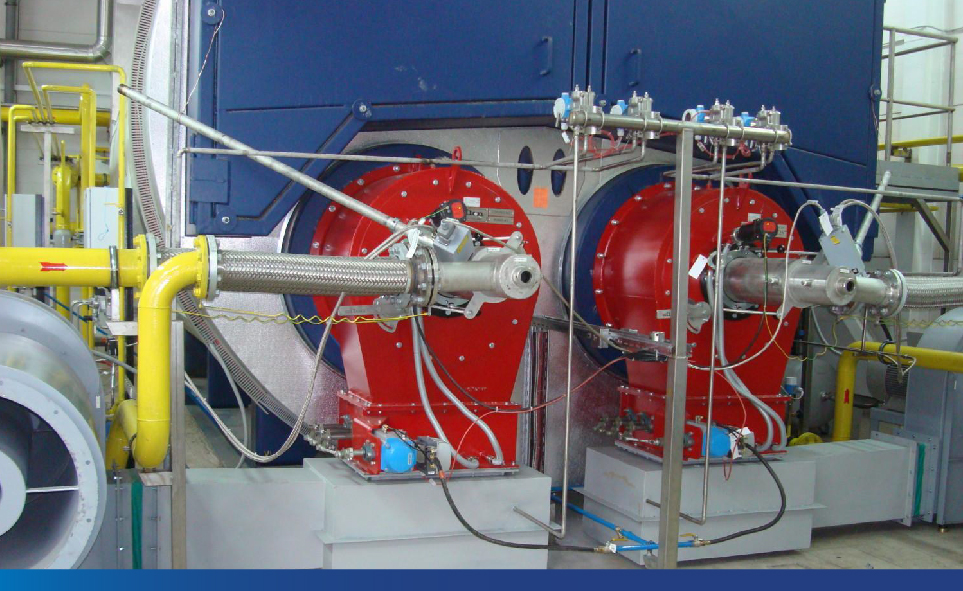Ever since the use of fossil fuels, human civilization records a progressive decrease in C:H ratio from wood to natural gas known as ‘De-carbonization Theory’. Natural gas is a suitable alternative in the context of possible coal transition to combat climate change until renewables form a significant proportion of the world’s energy mix. However, the decline in conventional natural gas reserves coupled with ever-growing energy demand encourages harnessing the huge nonconventional gas resources trapped in tight reservoirs or in permafrost regions/oceanic sediments. Conventional petroleum systems formed of geological formations are straightforward to extract fossil fuels using standard techniques and tend to be easier and less expensive to produce.
| Conventional Petroleum Systems | Nonconventional Petroleum Systems |
| Reservoir and source rock are independent | Reservoirs and source rock are same |
| Inorganic reservoir rock | Organic reservoir rock |
| Relatively high permeability reservoirs | Low permeability reservoirs |
| Gas storage in macro-pores | Gas storage by adsorption in micro-pore surfaces |
| Darcy flow of gas to wellbore | Desorption-Diffusion-Darcy Flow |
| Fracking job is not always required | Fracturing job is necessary |
On the other hand, natural gas resources, whose recovery technology is different from the conventional gas owing to their reservoir property (porosity, permeability etc.) are known as “nonconventional gas” resources. This requires a precise demarcation of non- conventional gas horizons and estimation of recoverable reserves to judge its economic viability. Many low permeability reservoirs made from coal seams, shales and carbonates may have an adequate store of natural gas. The three most common types of non-conventional gas resources are Coal Bed Methane (CBM), shale gas and tight sands. Besides that, gas-hydrate deposits are also considered as a non-conventional gas resource. Non-conventional reservoirs are essentially any reservoir that requires different recovery operations from the conventional operating practices. These reservoirs require specialized recovery techniques such as stimulation treatments or steam injection in a cost- effective manner in order to make them commercial prospects.
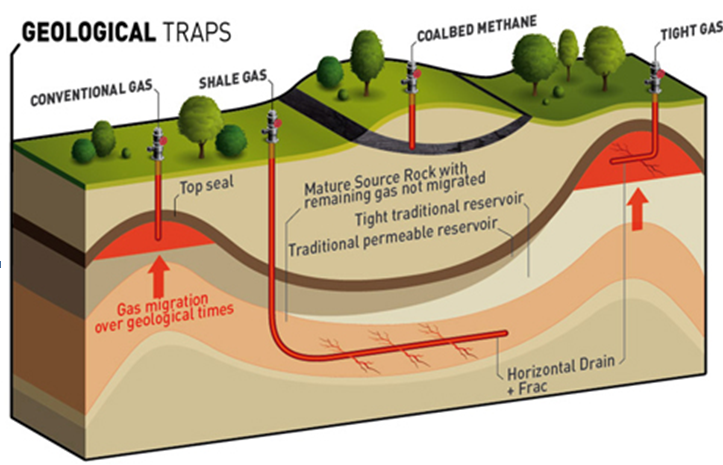
(Photo Credit: A. S. Elzafrany, 2016)
Methane is generated by microbial (biogenic) or thermal (thermogenic) processes shortly after burial and throughout the diagenetic cycle resulting from further burial. The gas retention mechanism in non-conventional reservoirs are markedly different from those of conventional gas reservoirs and includes adsorbed molecules on the surface, trapped gas within the matrix, free gas in fracture network, and as a solute in groundwater. While methane generation depends on the type of organic matter and the thermal maturation, its recovery is primarily guided by the porous network i.e., porosity and permeability. Porosity is the void space between the grains, and thus represents the rock’s capacity to contain fluids (liquid or gaseous hydrocarbons). The fluid must have the ability to flow through the interconnection of the grains present in the reservoir rock for efficient recovery; this property is known as permeability which dictates the economic viability of the reservoir.
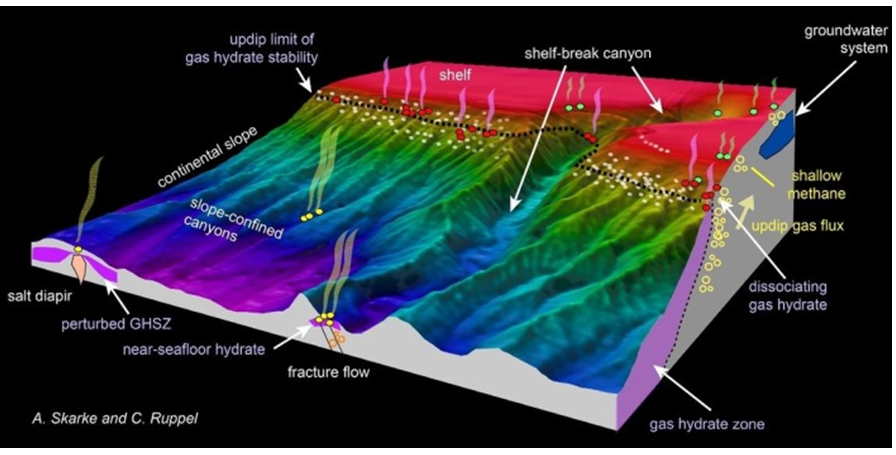
(Photo Credit: Carolyn Ruppel, www.usgs.gov/natural-hazards/)
Methane generated during coalification and retained in the coal seams is known as CBM. The total CBM reserve of the world is estimated at 33,853 TCF (trillion cubic feet). Most of the world’s CBM resources are concentrated in China, the USA, Australia, Canada, Russia and India. The prognosticated CBM resources stock of India is 91.8 TCF (DGH, 2019-20) distributed mostly in the state of Jharkhand, West Bengal and Chattisgarh.
Shale gas is a natural gas trapped within micro-pores in shale formations. It is a hydrocarbon gas mixture that mainly consists of methane. The total recoverable shale
gas resources of the world are 7299 TCF (EIA, 2014). China, Argentina, Algeria, the U.S, Canada are the leading countries with significant shale gas resources. Shale gas is distributed in Damodar, Son-Narmada, Cambay, Krishna-Godavari, Cauvery Basin, Indo- Gangetic, Assam-Arakan basins of India (DGH, 2020). The shale gas resources from Damodar, Cambay onland, Krishna-Godavari onland, Cauvery Basin onland is estimated at 584 TCF (EAI, 2013).
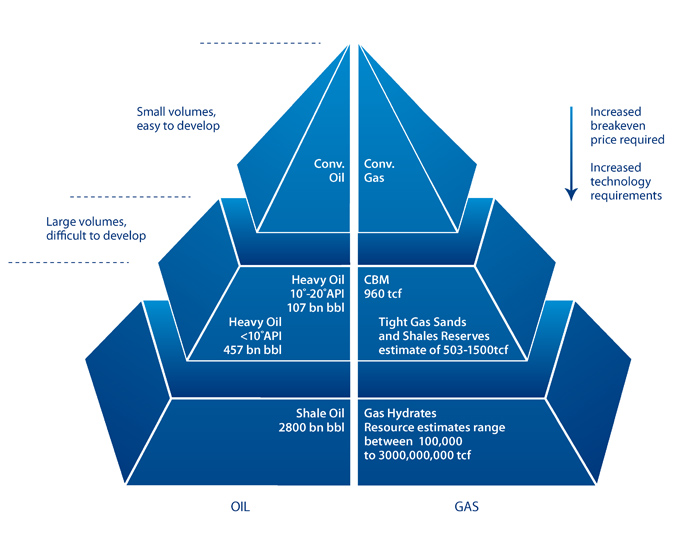
(Photo Credit: Wood Mackenzie, www.jsg.utexas.edu/)
Tight gas is a nonconventional natural gas whose reservoirs are formed from sandstone reservoirs with low permeability. Tight gas reservoirs are defined as having less than 0.1 millidarcy matrix permeability and less than 10% matrix porosity. Global resources of tight gas are estimated at 7400 TCF (Oil & Gas Journal, 2007) and found mostly in North America, Latin America, Europe, the Middle East, Sub-Sahara Africa and the Asia Pacific areas. Tight gas occurs in almost all oil-producing basins of India.
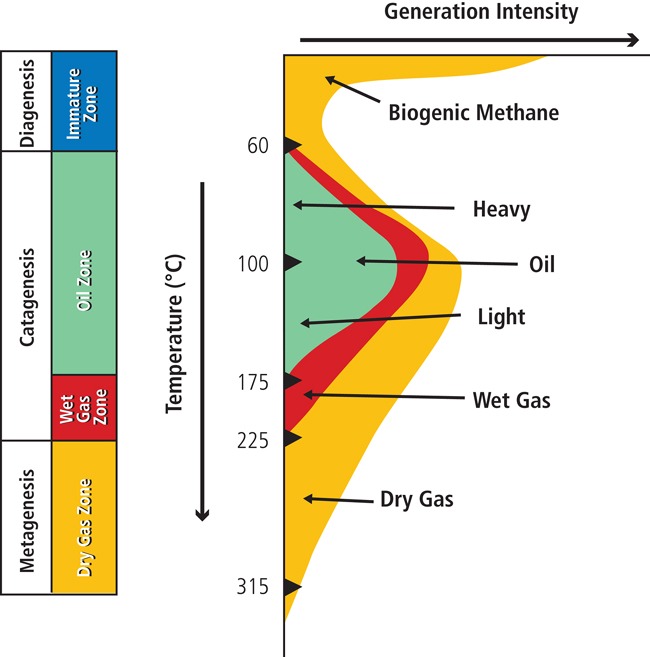
(Holditch 2011)www.routledgehandbooks.com/
Gas hydrates are a crystalline form of methane and water formed at high pressure and low temperature in permafrost regions and ocean sediments. Global gas hydrate resource is estimated at 1,00,000 to 3000,000,000 TCF. Large amounts of methane hydrate have been found beneath Arctic permafrost, beneath Antarctic ice, Blake Ridge, Gulf of Mexico, Nankai trough and Caspian sea, and in sedimentary deposits along continental margins worldwide. Krishna- Godavari, Cauvery and Kerala basins contribute an estimated 100-130 TCF of gas hydrate reserves in India (ONGC, 2016).

According to an International Institution, global non-conventional gas resources including tight gas, shale gas, and CBM are estimated at (800-6521)×1012 m3, accounting for about 1.7 to 13.8 times of the conventional gas resources (Zou et al., 2017). Some assume that the total amount of available natural gas hydrate resources is more than 45 times the amount of available conventional natural gas. Obviously, non-conventional gas resources have a great role in the future energy mix of the world. Technological innovations in assessment, exploration and exploitation are essential to make these resources commercially viable.
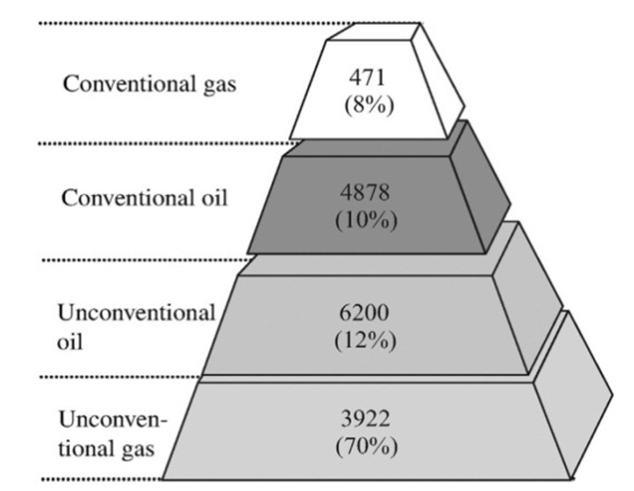
Pradeep K Singh, D. Mohanty, Ashis Mukherjee, CSIR-CIMFR, Dhanbad


